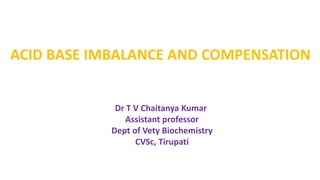
Acid Base Imbalance.pptx
- 1. ACID BASE IMBALANCE AND COMPENSATION Dr T V Chaitanya Kumar Assistant professor Dept of Vety Biochemistry CVSc, Tirupati
- 2. pH = - log [H+] Range is from 0 - 14 If [H+] is high, the solution is acidic; pH < 7 If [H+] is low, the solution is basic or alkaline ; pH > 7 What is pH?
- 3. 3 The Body and pH • Extracellular fluid = 7.4 • Blood = 7.35 – 7.45 • < 6.8 or > 8.0 death occurs • Acidosis (acidemia) below 7.35 • Alkalosis (alkalemia) above 7.45 • Homeostasis of pH is tightly controlled
- 4. Homeostasis of pH 1. Extracellular and intracellular buffering 2. Regulation of the rate of alveolar ventilation to control carbon dioxide concentration 3. Regulation of renal hydrogen excretion
- 5. How ECF and Cellular Buffers work Protein Buffer system
- 7. ACID BASE IMBALANCE •Metabolic acidosis • Metabolic acidosis is characterized by a decrease in pH and bicarbonate. • Addition of hydrogen ions or a loss of bicarbonate ions. • The initial buffering of an acid load is by the ECF buffers, primarily the bicarbonate-carbonic acid pair • Intracellular buffers, protein and phosphate, assist in the buffering process. • “ Cation shift ” results in hyperkalemia
- 8. Causes • Common causes include lactic acidosis; ketoacidosis • Gastrointestinal problems • Indigestion colic or diarrhea • Renal failure, which may result in a decreased ability to excrete hydrogen and thus to retain bicarbonate • Acidosis in calves and goat kids associated with diarrhea. • Increased anion gap. • Ingestion of certain salicylate, methanol, ethylene glycol, or paraldehyde
- 9. Compensation • Increased ventilation • Renal excretion of hydrogen ions • K+ exchanges with excess H+ in ECF ( H+ into cells, K+ out of cells) Respiratory response is a reduction of p CO 2 by 0.7 mmHg for each mEq/l decrease in bicarbonate
- 10. Respiratory Acidosis • Decrease in pH and an increase in p CO 2 . • decreased effective alveolar ventilation or breathing an atmosphere with elevated CO 2 . • Intracellular buffers. • The principal ECF buffer, the bicarbonate-carbonic acid buffer pair, cannot buffer a respiratory acidosis. • Carbon dioxide diffuses through the lung much more readily than O2 thus, diseases that compromise ventilation normally result in decreases in p O 2 before significant increases in p CO 2
- 11. • Causes • Primary pulmonary diseases : Acute upper respiratory obstruction, pneumonia, pneumothorax, chronic obstructive lung disease. • Diseases or drugs that inhibit the medullary respiratory center • General anesthesia with volatile agents using a closed system. • Emphysema • Compensation • Increased excretion of hydrogen ion, chronic respiratory acidosis. • 0.35 mEq/l of bicarbonate is anticipated for each mm Hg increase in p CO 2 • Exogenous bicarbonate is unnecessary, and should bicarbonate be administered to patients with a respiratory acidosis, it would be excreted without affecting the final plasma bicarbonate concentration.
- 12. Metabolic Alkalosis • Increase in pH and bicarbonate. • Digestive disturbances in ruminants. • Metabolic alkalosis requires an initiating process and maintaining the alkalosis. • Generation of metabolic alkalosis • excessive hydrogen loss, • Bicarbonate retention, • Contraction alkalosis: Excess loss of ECF (sodium and chloride)
- 13. Causes • Gastrointestinal losses of chloride-rich fluids associated with vomiting in small animals or sequestration of chloride-rich fluid in the abomasum and fore stomach of ruminants • Mineralocorticoid excess • Diuretic usage , low chloride intake cause or contribute to the generation of a metabolic alkalosis • Decreased effective circulating volume induce are central features of the processes • Potassium depletion (hypokalemia) • Decreased glomerular filtration of bicarbonate
- 14. Compensation • Chemoreceptors in the respiratory center sense the alkalosis, and the respiratory response to a metabolic alkalosis is hypoventilation resulting in an increase in p CO 2 . In dogs, the expected compensating response is an increase of p CO 2 of 0.7 mmHg for each mEq/l increase in bicarbonate.
- 15. Respiratory Alkalosis • Increase in pH and a decrease in p CO 2 . • Causes: • Respiratory alkalosis is due to hyperventilation due to hypoxemia (Anemia) • Hyperventilation may also be associated with psychogenic disturbances or neurological disorders that stimulate the medullary respiratory center • Salicylate intoxication • Gram-negative sepsis. • Hyperventilation may occur in dogs and other nonsweating animals as they employ respiratory evaporative processes for heat loss to prevent overheating
- 16. Compensation • Cellular buffering • Renal responses result in decreased ECF bicarbonate concentration through reduced renal bicarbonate reabsorption. • The decline in bicarbonate is partially offset by chloride retention in order to retain electro neutrality. Thus, hyperchloremia • In dogs, anticipated renal compensation for a chronic respiratory alkalosis results in a decrease of bicarbonate of 0.55 mEq/l for each mmHg decrease in p CO 2
- 17. Mixed acid base imbalance • Overcompensation • Anion gap = (sodium + potassium) - (chloride + bicarbonate)
- 18. 18 Diagnosis of Acid-Base Imbalances 1. Note whether the pH is low (acidosis) or high (alkalosis) 2. Decide which value, pCO2 or HCO3 - , is outside the normal range and could be the cause of the problem. If the cause is a change in pCO2, the problem is respiratory. If the cause is HCO3 - the problem is metabolic. 3. Look at the value that doesn’t correspond to the observed pH change. If it is inside the normal range, there is no compensation occurring. If it is outside the normal range, the body is partially compensating for the problem.
- 19. 19 Example • A patient is in intensive care because he suffered a severe myocardial infarction 3 days ago. The lab reports the following values from an arterial blood sample: • pH 7.3 • HCO3- = 20 mEq / L ( 22 - 26) • pCO2 = 32 mm Hg (35 - 45) Diagnosis • Metabolic acidosis • With compensation
- 20. 20